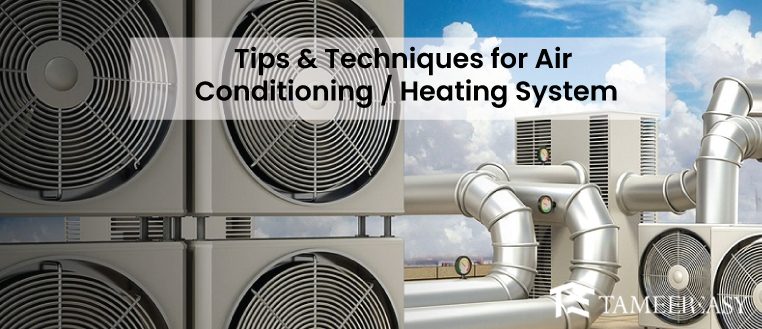Introduction
Installing a heating or cooling system is a substantial investment that may significantly improve your home’s or working environment’s efficiency and comfort. It is crucial to adhere to best practices and methodologies to guarantee a flawless installation and maximise the efficiency of your system.
In this post, we’ll look at ten essential pointers that can aid you in installing an air conditioning/heating system, enabling you to make your home comfortable while maximising energy efficiency and financial viability.
Ten Best Tips & Techniques for Installing Air Conditioning/Heating System
1). Determine Your Needs
It’s crucial to evaluate your unique requirements before starting the installation process. Think about the space’s dimensions, insulation, and preferred temperature range. Consider the cooling or heating load based on the area’s dimensions and direction.
The number of people using it and the heat produced by any appliances or electrical gadgets should also be taken into account. You may choose the best system and ensure its peak performance by being aware of these elements.
2). Choose the Right System
Many heating and cooling systems, including heat pumps, central systems, and split units, are available. Depending on elements like energy efficiency, cost-effectiveness, and functionality, each has pros and cons.
After thoroughly researching these possibilities, select the system that best fits your goals and budget. Consult with HVAC experts who can offer insightful opinions and suggestions based on your unique needs.
3). Professional Assessment
It is strongly advised to seek the help of HVAC professionals, especially for complex installations or if you need more technical understanding. Accurate calculations of cooling or heating loads, ductwork needs, and system compatibility are ensured by a professional evaluation.
They can also help you avoid costly errors throughout installation by identifying potential problems and providing workable solutions.
4). Energy Efficiency Considerations
Installing an energy-efficient heating or cooling system minimises the environmental impact while lowering utility costs. Seek systems with high Heating Seasonal Performance Factor (HSPF) ratings and Seasonal Energy Efficiency Ratio (SEER).
Think of systems that have zoning capabilities, variable speed motors, and programmable thermostats. Proper duct insulation and sealing are essential to stop air leakage and increase energy efficiency.
5). Plan for Proper Ductwork
The design and installation of the ductwork significantly influence your HVAC system’s performance and efficiency. Ducts with insufficient airflow, improper design, or improper installation can reduce system effectiveness.
To reduce energy loss and increase airflow, ensure that ducts are the right size, insulated, and sealed. Collaborate with HVAC experts to create a ducting system appropriate for your space and system.
6). Adequate Ventilation
Proper ventilation is crucial for maintaining high indoor air quality and avoiding the accumulation of pollutants and excessive moisture. As local building processes requirements require, ensure your HVAC system has enough ventilation components, such as fresh air intakes and exhaust fans.
Creating a healthier and more comfortable indoor atmosphere is aided by proper ventilation, which helps control humidity levels and eradicate odours.
7). Follow the Manufacturer’s Guidelines
During installation, carefully read and follow the manufacturer’s recommendations and instructions. Manufacturers offer detailed instructions for system wiring, refrigerant charging, and safety measures. Adhering to these recommendations ensures that your system runs well, reduces the possibility of faults, and validates your warranty.
8). Proper Refrigerant Handling
During the installation procedure, it is vital to handle refrigerant safely. Refrigerant handling or charging errors can result in system inefficiencies, higher energy costs, and potential environmental harm. To avoid leaks:
- Make sure that all refrigerant connections are correctly sealed.
- Observe the correct charging techniques while paying attention to the manufacturer’s recommendations.
- Use only the type and quantity of refrigerant recommended for your system.
Inadequate refrigerant management compromises the efficiency of your heating and cooling system and puts your health and safety at risk. Always speak with HVAC experts to ensure the correct handling and charging of refrigerant during installation.
9). Professional Installation
Although some HVAC enthusiasts could try a DIY installation, it is strongly advised to use expert specialists. HVAC specialists have the knowledge, skills, and equipment to guarantee flawless installation. They know their area’s building codes, safety rules, and industry best practices.
Professional installation ensures proper system configuration, accurate refrigerant charge, right wiring, and extensive system testing. In addition to saving you time and effort, hiring a professional installer assures you that your heating or cooling system is installed correctly and will work effectively.
10). Regular Maintenance and Servicing
To guarantee that your system continues to work efficiently, schedule routine inspections and maintenance with HVAC professionals. Filters should be cleaned or replaced, refrigerant levels should be checked, electrical connections should be examined, and moving parts should be lubricated.
Regular maintenance increases energy efficiency and system lifespan and maintains the highest level of interior comfort. It also helps prevent unanticipated malfunctions. After installation, pay attention to the value of routine upkeep and servicing.
Conclusion
Planning and attention to detail are essential when installing a Air Conditioning/Heating System. Each step in the installation process is essential, from determining your needs and choosing the appropriate system to professional assessment, energy efficiency considerations, and suitable ductwork. Adhering to this article’s ten tips and tricks may guarantee a good installation that maximises comfort, energy efficiency, and cost-effectiveness.
Always follow the manufacturer’s instructions, handle refrigerant safely, choose professional installation, and place an emphasis on routine maintenance. By doing this, you’ll benefit from a well-installed heating or cooling system that produces a cosy and enjoyable environment all year long.








